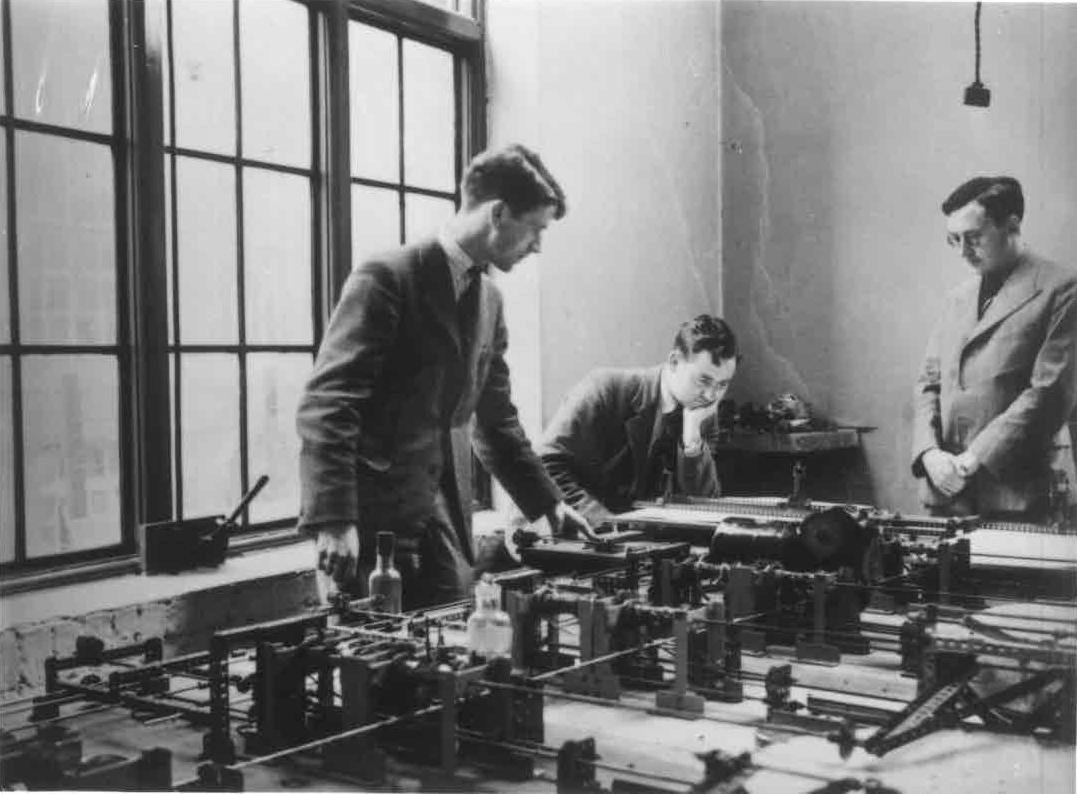
Maurice Wilkes (right) with the Cambridge Meccano differential analyser in 1938
| Resurrection Home | Previous issue | Next issue | View Original Cover |
Computer
RESURRECTION
The Bulletin of the Computer Conservation Society
ISSN 0958-7403
Number 53 |
Winter 2010/11 |
| Obituary : Professor Sir Maurice Wilkes 1913-2010 | David Barron |
| Society Activity | |
| News Round-Up | |
| The Information Society | Dik Leatherdale |
| The Pegasus Incident and its Aftermath | Chris Burton |
| As Others See Us | Loes Peeperkorn |
| Pioneer Profile: Ada Lovelace | Doron Swade |
| Forthcoming Events | |
| Committee of the Society | |
| Aims and Objectives |
This edition of Resurrection is respectfully dedicated to the memory of Sir Maurice Wilkes. |
Cover photograph by Simon Moore. Photographs on cover and in the Obituary courtesy of Cambridge University Computer Laboratory.
| Top | Previous | Next |
Members of the CCS will probably know that Maurice Wilkes, the Grand Old Man of British computing, died on 29 November 2010, aged 97. Obituaries have appeared in many newspapers, including a particularly good one in The Independent by Martin Campbell-Kelly, “purveyor of obituaries to the Computing Science gentry”. (Mind you, Maurice would not have wished to be remembered as a Computer Scientist. When the University of Cambridge belatedly awarded him a Personal Chair, he chose the title “Professor of Computer Technology”. Asked why he had not chosen the then fashionable term ‘Computer Science’, he replied “I’ve been a scientist, and I know the difference”. And when his daughter went to University, he confided to me “The course is called Computer Science. But it’s not Computing as you and I know it, David.”.) It is not my intention to try to produce another formal obituary: rather, I offer a personal memoir of a great man whose path crossed mine quite by accident when I was young, and changed the course of my life.
In 1956 I joined the Cavendish Laboratory as a research student. My supervisor outlined a particularly intractable problem concerning the propagation of radio waves in the Ionosphere, which could only be solved, if at all, using numerical methods. In a throw-away remark he said “there’s this computer in the Mathematical Laboratory: you might like to go over there and see if it can help”. So I did, and discovered that the EDSAC might well be the answer to our prayers. Perhaps impressed by my enthusiasm, Maurice offered me a desk in the Lab, and so a lifetime career in computing started. (Alongside his more obvious achievements, Maurice should be remembered for inspiring generations of young scientists.)
If Maurice had done nothing after building the EDSAC, he would still deserve his place in the Computing Hall of Fame. At the time, many Universities were embarked on the project of building a computer. For most of them, it was an end in itself: they hadn’t really thought about what they would do with the machine once it was built. Maurice, though, had a very clear view: he wanted to build a machine that could be used by people whose primary interest was not computing in itself - researchers in all branches of physical science in Cambridge - as a tool to advance their research. We must remember that from his pre-war experience in the Mathematical Laboratory he was familiar with the application of numerical methods to scientific problems using hand calculators like the Brunsviga and electro-mechanical machines. It was this desire to produce a tool that influenced the conservative engineering design of the EDSAC: the machine would almost certainly have run a double the clock speed, but from his previous experience Maurice knew that anything electronic would be so much faster than mechanical calculators that users would be happy whatever the speed. So he went for reliability, not speed. And he succeeded in spades. The Mathematical Laboratory became a centre for a collection of astronomers, crystallographers, radio physicists, theoretical chemists and many more. A generation of scientists who regarded the computer as an essential tool was born.
In this vision of the role of the EDSAC, Maurice exhibited for the first time what was to be the defining characteristic of his career: the ability to spot a trend as a likely winner, pick it up and run with it, so that when the rest of the world caught up, he was out in front. (Coupled with this was the ability to drop an idea immediately if it became apparent that it was a turkey.) Examples abound. During the development of the Titan (Atlas 2) machine, he came back from a visit to MIT enthused by CTSS, the first multi-access time-sharing system. He was determined that the Titan should be a time-sharing system, and despite the opposition of all his staff (myself included) he got his way. On another visit to the States he encountered Ivan Sutherland’s “Sketchpad” system, and immediately saw the possibilities of Computer Aided design. Shortly after his return he set up the first CAD research in the country. We acquired a PDP 7 and a DEC 340 visual display (the first outside the USA) to be attached to the Titan, and poached an ex-pat from MIT to lead the team. This work formed the basis for a research grant to develop CAD in Britain, which led to the establishment of the Government-funded CAD Centre at Cambridge.
Later, as small “personal” computers were becoming available he saw the possibilities opened up if they were to be connected in a high-speed local network. (Typical Maurice, he purchased a number of identical small machines, put them in a lab and invited his staff to see what they could do.) The result was the Cambridge Ring, the first-ever LAN. The fact that eventually local networking was based on Ethernet with TCP/IP is no discredit to Maurice: his satisfaction was in showing that things could be done. If I had space, I could continue this list at length.
Right at the beginning, Cambridge recognised the need for courses in computing techniques, and in 1953 Maurice established a world first, the Diploma in Numerical Analysis and Automatic Computing. This went on for 55 years, changing its name to the Diploma in Computer Science somewhere along the way. He was less keen to join the rat-race of undergraduate teaching, rightly recognising the likely effect of this on the research activity of the Lab, and so the full Computer Science Tripos was a late arrival on the scene in 1978.
Whilst always at the sharp end of the technology, Maurice also had a deep interest in the history of computing, and contributed much to the history of Babbage’s work, based on a study of the Babbage manuscripts in the Science Museum Library. And he took great pleasure in maintaining the traditions of the old Cambridge through his Fellowship of St John’s College. Up to a month before his death he was still dining regularly at High Table in St John’s
One last memory, from the EDSAC 60 meeting at the Computer Lab in 2009 to celebrate the 60th anniversary of the EDSAC running its first program. Maurice had expressed a wish not to be involved as a main speaker, but volunteered to offer a few words at the end. So he sat in the front row listening to the presentations, and when invited to close the proceedings rose, slightly unsteadily, to his feet. The packed lecture theatre erupted into a spontaneous round of applause. The look of pleasure on his face said it all. He will be remembered for his many technical innovations, and for inspiring many generations of his “young men and women”, who went on to fill many of the Chairs of Computer Science across the country. Requiescat in Pace.

|
Maurice Wilkes (right) with the Cambridge Meccano differential analyser in 1938 |
| Top | Previous | Next |
ICT 1301 - Rod Brown
The project is now slowing down towards the annual winter closure. However the work continues on the important data transfer interface. Further, the project has hosted both an open day which saw Ken Barnes, one of the original system software authors, visit on the 11th October. It has also delivered a presentation encapsulating a brief look at computer history, and the part played by the 1301’s designer Dr Bird, to the Computer Department of the University of Kent.
Rather than get stuck in a rut, the project takes some time away from the data transfer interface (when awaiting spare parts to arrive) and the last visit to the project saw us starting on the current card punch and card reader problems. Sometime recently the card punch was driven backwards when a pair of the three phase power lines were reversed. After a major set-up of the timing cams the punch is behaving much better and will be fully tested soon.
The card reader has also suffered from the phase reversal problem. Work is now going on to address this and other problems. These include a card image decoder with a few of the previous owners’ modifications. We are also trying to set the photo electric card track timing up to allow us to capture card data.
Some initial consideration is being given to modifying the status of the project to allow its potential move to that of a charitable trust and its further ability to function as a fully interactive experience which we would like to offer to students of both computing and digital archaeology.
We are also planning to change the 2012 public open day into an event which celebrates the 50 years during which this machine will have existed. We will also be focusing on the Turing anniversary in the same year.
News about the project can be found on both the CCS website and the dedicated project website www.ict1301.co.uk, For visitors to this site we now have the MPL2 manual and the TAS (Thirteen hundred Assembly System) online in PDF format.
Elliott 803 - Peter Onion
The promised Calcomp 565 plotter has been received, and it is in very good condition. It had not been used for a number of years so as a precaution the circuit board was removed and the power supply capacitors slowly brought up to working voltage. It came complete with manual and a selection of pens which are still working!
Initially it is being driven via a PIC based interface, but since we have the circuit diagram of the original minilog based interface we have started to build a replica of that using one of the many spare logic boards which already had a number of the correct types of minilog mounted in the correct positions. The ultimate aim is to build a loose replica of the box that housed the interface.
The plotter has been on display with the 803 running a mixture of programs that came from Loughborough Grammar School together with more recently written ones.
We′ve only had one fault on the 803 since the last report. It looked like it was going to be hard to find but turned out to be a loose connection on the boards that provide the 40 bit parallel interface to the core store. This interface is used by block transfer devices (DMA in modern terms) and since we don′t have any of those, the short term solution has been to simply remove the boards.
In other news, TNMoC has been offered an Elliott 903. This is currently in a completely disassembled state and has been stored in a not particularly good environment. It certainly will need physical restoration before any electronic work can begin. Since there are several other working 903s still in existence, and since it is mostly dismantled, a “steam engine” style restoration back to its original state may be the most appropriate course to take to ensure it can be got into a working state and maintained that way for many years to come.
Pegasus - Len Hewitt
Although the Science Museum authorised the repair of Pegasus in early 2010, the project team was not allowed to proceed until August due to the concern about asbestos in the fuses. The fuses were replaced by versions without asbestos and were reloaded with the correct value fuse wire. The burned cabling was replaced and the motorised margin rheostat circuits were traced and a circuit diagram was produced as no circuits existed for this part of the power supply.
I had meetings with Geoffrey Stokes, the consultant who the Science Museum wish to authorise the safety of Pegasus. We have followed his recommendations on checking the interconnections between the various parts of the machine.
Initially the work was carried out by Peter Holland and myself with tremendous help and assistance from Science Museum conservator Ian Miles. When I was incapacitated at the end of September, Rod Brown and Peter took on the remaining tasks. Chris Burton also rendered valuable service in tracing the circuitry and drawing up the new circuit diagrams. We have now completed 95% of the outstanding tasks and have determined that the metal rectifiers have suffered no damage using test equipment designed and built by Rod Brown.
As I am in California until April we cannot proceed further with the connection of power until my return. Pegasus has been disturbed much more than the previous two moves with which I have been associated, but I am fairly confident we will be running again next year.
We have had another volunteer for the project. David Mitchell who used to be a member when were in the Old Canteen has re-joined and we have another member wishing to join who is Peter Lawrence from the Elliot 401 Working Party. We have presently lost the services of Martin Wingstedt who has been a stalwart member of the Project for 17 years or so. We hope he is able to join us again soon.
Bombe Rebuild - John Harper
Demonstrations at weekends continue with all Sundays covered but there is the odd Saturday that we have to miss due to shortage of volunteers. However we are holding a technical session for tour guides on the 23rd November with two objectives. The first is to give the many recent volunteer guides more information about the Enigma and Bombe. The second objective is to see if any guides are interested in becoming Bombe demonstrators. Some of our longer serving guides are finding that taking tours around the site in winter is rather tiring and are attracted to an “inside” task.
We continue to develop and run new menus and a recent one has uncovered marginal unreliability issues. Applying a more precise mechanical timing procedure has now cured this. This unreliability only showed itself on new menus so the weekend demonstrations were not affected.
Our website is still at https://www.bombe.org.uk/
Harwell Dekatron Computer - Tony Frazer
Eddie and Johan have been continuing with dormant fault checking on the rack wiring.
Whilst demonstrating the HDC to group of students we noticed that if memory locations 8 or 9 were selected in Receive Mode, then both memory stores would be seized. If the stores were seized in Send Mode then all was OK. Johan and Eddie proved that on “5th Digit Selection” a short circuit existed between digits 8 and 9 wiring. After breaking down the circuit the fault proved to be coming from the W Relay Set, U-Points 13 and 15. The W Relay Set was removed from the rack and the wiring checked for any obvious signs of a fault. When the relay set was returned to the rack the fault condition had cleared and the memory stores could be accessed correctly.
I have almost completed checking the units of the arithmetic rack, cleaning the units, testing valves, passive components and wiring. I designed and built a Trigger Tube Tester for the many GTE175M tubes in the various accumulator plug- in modules.
We are giving regular talks about the computer to visitors, particularly to our weekday school and college parties, the highlight of which is a demonstration of the relay racks and tape readers in operation, running a simple program to transfer control between two tape readers. The restoration project was recently represented at the R3PLAY gaming event in Blackpool, with a video, Dekatron spinner and posters which were reported to have attracted much interest with visitors.
The Hartree Differential Analyser - Charles Lindsey
Our team has been augmented by a new member - Dave Wade - so there are now four of us (myself, Brian Russell, Bill Purvis and Dave). The work on the shafts connecting to the two integrators (involving much disassembly and reassembly) is now complete, but it was harder than expected and showed up much damage done by past amateurish maintenance of the machine. The disassembled parts were photographed for the benefit of the next person who might need to take it all apart again. The de-burring gadget has seen much use. The main drive motor has now been reunited with its pulley, and returned to the machine. Arrangements to connect its electrical supply are in hand. In the meantime, it has been possible to use the one working integrator to generate an exponential, which has thrown up the need for a fuller understanding of how to adjust the torque amplifiers. Restoration of the output table has been started.
EDSAC Replica - Kevin Murrell & David Hartley
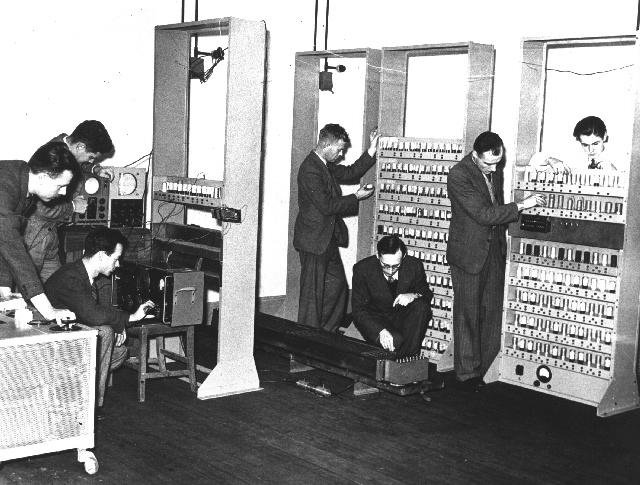
|
Building the original EDSAC in 1947 |
CCS is delighted to announce a new project to build a replica of the original EDSAC computer. The project is in the early stages of planning and fundraising, but there is much confidence that a replica can be produce in a reasonable timescale.
EDSAC was developed at Cambridge University and ran its first program in 1949.
At this stage the Society is researching as much of the history of the machine as we can find - early articles, original artefacts and memories of the engineers involved in the construction of the machine. Kevin Murrell, Martin Campbell-Kelly, Chris Burton and David Hartley are driving the project.
“The building of a replica EDSAC will be a fitting memorial to Maurice Wilkes.” opined David Hartley
SSEM Replica - Cat Rushmore
In November, as the redevelopment of the Museum of Science and Industry in Manchester neared its end, the “Manchester Baby” was moved to the new Revolution Manchester gallery. The replica Baby will form the centrepiece of the computer story, one of six themes dedicated to locally-originated developments of important technology. Formal opening of the new displays is expected in February 2011.
ICL 2966
The Society has adopted the ongoing project to bring a 2966 back to life at TNMoC. Delwyn Holroyd is the project leader and is a welcome new addition to the Society Committee. We hope to bring you an introduction to the project in a future edition of Resurrection.
| Top | Previous | Next |
Readers will be familiar with the heroic construction of the Babbage Difference Engine No. 2 at the London Science Museum masterminded by Doron Swade. Now a new proposal to construct Babbage’s later Analytical Engine has been floated. Like the Difference Engine, the Analytical Engine was entirely mechanical in nature but neither was ever constructed by Babbage. Indeed, the Analytical Engine remains unrealised to this day.
The Analytical Engine was to have been controlled by programs stored on punched cards similar to those used in a Jacquard Loom. Thus the design was for a general-purpose computer rather than a calculator like the Difference Engine. Initial data storage of 100 variables was proposed and the whole machine was to have been powered by a steam engine. Over 100 years later, Howard Aiken acknowledged the debt owed by the Harvard Mark 1 (IBM’s first foray into computers) to the work of Babbage.
John Graham-Cumming, previously known to us as the person behind the recent successful Downing Street e-petition for a posthumous public apology to Alan Turing, is the driving force responsible for this notion. In order to assess whether the project is financially viable, pledges of support are being sought on the Web. You are invited to visit plan28.org to find out more and to express your support should you feel moved so to do.
-101010101-
On 23rd November an auction of interesting material was held at Christies. A collection of published Alan Turing papers previously the property of the late Max Newman failed to find a buyer despite a public appeal and a generous pledge of $100,000 from Google. Similarly a first edition of Wilkes, Wheeler and Gill (see Resurrection 46) and a first edition of Babbage’s On a method of expressing by signs the action of machinery also remained unsold.
On the other hand, an Apple 1 made an outrageous £133,250. The original price was $666.66 without the little matter of a keyboard or a monitor. Only 200 Apple 1s were made. Steve Wozniak was in attendance at the sale. One blogger claimed he passed up on this same machine at a California swapmeet 10+ years ago because he couldn’t be bothered to go to an ATM to get the requested $250. Bad decision.
-101010101-
We regret to report the passing of three other distinguished figures from the early days of computing
John Bennett was Maurice Wilkes’ first research student in 1947-50. He designed and built EDSAC’s main control unit before moving to Ferranti making important contributions to Mark 1* and Persueus. Returning to his native Australia, he was awarded the chair of Computer Science at Sydney University and helped found the Australian Computer Society. It seems appropriate to recommend his Sydney Morning Herald obituary at www.smh.com.au/national/obituaries/australian-computing-pioneer-pushed- technological-frontiers-20101226-197uy.html.
Harry Fensom, was a veteran of Tommy Flowers’ team of Post Office electronics engineers who built Colossus at Dollis Hill. Harry went on to take part in the building of the first ERNIE now on display in the Science Museum. He also made contributions to the re-creation of Colossus at Bletchley Park. An obituary was published in the Guardian at www.guardian.co.uk/theguardian/2010/nov/08/harry-fensom-obituary.
Finally, Harry Carpenter was an important member of that seminal team which flowered for a brief period in the early 1950s at Elliotts in Borhamwood. Much of his work there was defence-related and hence is relatively unknown, but with Andrew St Johnston he was responsible for planning the NRDC-Elliott 401. The BCS published an obituary at www.bcs.org/server.php?show=conWebDoc.38504.
Also recommended is Martin Campbell-Kelly’s excellent obituary of Sir Maurice Wilkes in The Independent at www.independent.co.uk/news/obituaries/maurice-wilkes-visionary-and-pioneering- doyen-of-british-computing-2147811.html.
-101010101-
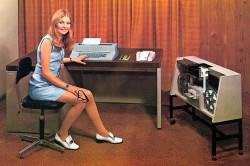
A BCL Susie computer of 1967 has recently been acquired by the Centre for Computing History in Haverhill, Suffolk. Further details can be found at www.computinghistory.org.uk/news/9513/Susie-Visits-the-Museum-and-stays.
-101010101-

|
George in 1950 |
A new arrival at the National Museum of Computing is “George” a humanoid robot built from old bits of Wellington bomber by a certain Pilot Officer Sale at RAF Debden in 1950. George bears a passing resemblance (or is it the other way round?) to the 1981 version of Marvin the Paranoid Android in Douglas Adams’ The Hitchhiker’s Guide to the Galaxy, not least in the manner of his gait which can best be described as “shuffling”. Happily, unlike the depressing Marvin, George is mute but is able to follow a light source.
George has spent the last 45 years in Tony Sale’s garage before being disinterred recently for an appearance in Wallace and Gromitt’s World of Invention (BBC1 17th November). www.bbc.co.uk/news/technology-11766846 gives an excellent account complete with contemporary film not only of George but of a teenage Tony Sale!
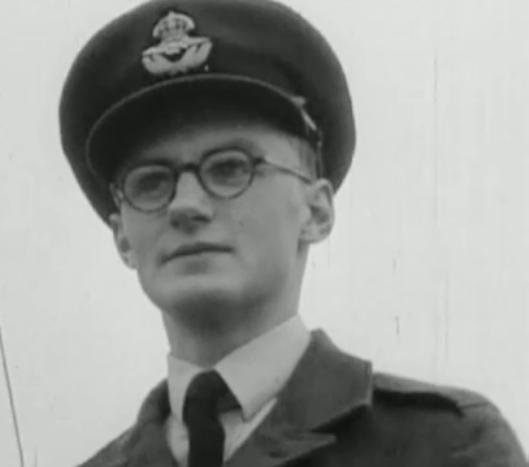
|
Pilot Officer Sale |
The following Tuesday the programme was rehashed without attribution in the Daily Mail. Their report was, in turn, picked up by the Today Programme which characterised George as “a fraud” for his inability to do housework as claimed 60 years ago. True, but hardly news as Tony said as much on prime- time television the previous week.
Honestly, the standard of journalism these days! One despairs.
-101010101-
In October a new design for the 50p coin was introduced. The designer is one Thomas Babbage. It is not known whether he is related to the great man.
-101010101-
Stafford is the location for a computer museum hitherto unknown to us. Part of Staffordshire University, the museum was set up in 2007 and was sponsored by the BCS as part of BCS@50. We have yet to receive a report from members who have actually visited. The site at which English Electric Deuce computers were tested is nearby.
-101010101-
The School of Computer Science at Newcastle University will be celebrating Brian Randell’s 75th birthday with a conference on the 7th and 8th of April which will recognise his outstanding 50-year contribution to computer science and computer history.
Corrections and Clarifications
In Resurrection 52 we stated that Mary Croarken worked on the Manchester Differential Analyser under Hartree. This is incorrect.
In the article on MVSL There is a discussion on theme of tri-valued Boolean logic. The symbol ≡ is wrongly rendered as _ in the printed version but is correct in the website.
In Resurrection 49 the article on motorway signalling systems has a section headed “Site Data”. The third sentence should read “When CP6 was shut down, the standby half-system of CP5 was used instead...”
Contact detailsReaders wishing to contact the Editor may do so by email to |
| Top | Previous | Next |
Your editor is often emailed by complete strangers with queries about the history of computing. He is, he suspects, not alone.
In the last few weeks he has provided information on the use of the Ferranti Pegasus in the design of the Vickers VC10 and found pictures of an English Electric System 4 for a reader who had a boyhood memory of being taken to see the computer upon which his late father worked long ago. Incidentally, why are photographs of System 4 so hard to come by on the Web? An enquiry concerning the opening ceremony of the London Atlas is also under way as I write.
It’s always a joy to get this sort of request. Apart from anything else, a couple of hours spent rooting around the Web looking for something often turns up fascinating titbits completely unrelated to the task in hand. The Pegasus query, for example, revealed that our supposition that two Ferranti-Packard FP6000 machines were imported to the UK for use in the development of the ICT 1900 Series is not the whole story. For we have identified a third FP6000 in use at Ferranti Edinburgh.
But the icing on the cake came with an enquiry from Cevn Vibert of THALES (a continuation of Ferranti by other means). Cevn is looking for Ferranti Argus 500/700/PMS systems or parts thereof to keep the surviving population of Argi going. As you might expect, a quarter century or so after ceasing production, spares are becoming rather hard to find, hence the appeal. Argus Documentation and Elliott ERTN39203/18 relays are also being sought. Happily, TNMoC has some surplus but incomplete Argi and has offered to assist. If you can provide any further help, please contact .
We can also report that we have just been approached to see whether we can find any information about the DataFair exhibition held in Manchester in 1969 and which featured speakers from NASA, presumably about the then recent moon landing. If anybody can help, especially about the NASA lecture, please contact the editor.
Never let it be said that the Computer Conservation Society is inward looking.
We’re delighted to help and share such knowledge as we have.
| Top | Previous | Next |
Readers will be all too aware that the Science Museum’s Pegasus has been hors de combat since summer 2009. Here we consider the story of “The Incident”, draw conclusions and learn lessons
The Ferranti Pegasus computer, no 25, was the first restoration project undertaken by Computer Conservation Society (CCS) member volunteers at the Science Museum, marking the start of a continuing constructive partnership between museum staff and volunteer technical experts.
Strictly speaking, the project was not a restoration, because the machine had never been abandoned in a non-working state. As many readers will know, Pegasus no. 25 was built in 1959 and destined for Skandia Insurance in Stockholm, via Ferranti’s agent there, L.M.Ericsson. As a result of problems with locally provided input-output equipment, the system was returned to the West Gorton factory. It was retained there to help with the commissioning of further Pegasus systems, and also to provide some internal data processing in the factory. In its commissioning rôle it was substantially modified and enhanced. Eventually it was transferred at low or no cost to University College London (UCL), where it was mainly used for crystallographic analysis for twenty years from 1964 to 1983. In that time it acquired numerous spare parts from other Pegasus systems being de-commissioned. It became redundant from UCL and was offered to and eventually acquired by the Science Museum. Due to lack of storage space it was temporarily transferred back to West Gorton where it was originally built and, through the generosity of the then company ICL, was re-assembled in a specially- made display room in 1950s style within the modern computer laboratories. Les Mander, the freelance engineer who had looked after it at UCL, came up to West Gorton, and with the help of Keith Wood and myself it was quickly got into working order so we could give demonstrations to visitors to the West Gorton plant. Keith and I would maintain it in our spare time with occasional dispensation from our manager to take an hour or two off from our desks to run a demonstration. It was there that I first met its owner, Doron Swade, Curator of Computing at the Science Museum.
After a few years, ICL could no longer justify the significant space occupied by the machine, so it was once more dismantled and shipped to the Science Museum storage facility at Hayes in West London. Though out of sight it remained in the inward eye of we who had been looking after it as well as of the museum, and was perhaps one of the catalysts for forming the Computer Conservation Society in 1989. Tony Sale, the first secretary of the CCS, was manager of the Information Age project at the museum, and he laid the groundwork for moving the Pegasus out of storage and into a spacious area in the Old Canteen, where the Wellcome Wing now is. John Cooper of the CCS was appointed the first Pegasus Working Party chairman, with a team of half a dozen volunteers. We re-assembled the machine and got it working once more. A regime of “In Steam” days started when volunteers would come into the museum and work on this and other systems being restored and operated.

|
Pegasus in the Science Museum gallery |
Since that time in the early 1990s, Pegasus has been kept in working order and regularly demonstrated to interested people. There was a break in continuity when the Old Canteen was demolished, whereupon the machine was dismantled, moved and re-assembled yet again in the museum’s storage space at Blyth House, West Kensington. Although there were no significant demonstrations, the machine was kept working, maintained, and software developed for the four years from 1997 to 2000. Finally, the machine came into the Computing Gallery at South Kensington, where running regular demonstrations to the public was scheduled in alternate weeks, typically on a Wednesday or a Thursday. This was under the leadership of the present Project Leader Len Hewitt with a loyal team of engineers and programmers. Throughout this period, relations between the museum staff and volunteers have been exceptionally cordial, with rare frustrating moments.
This 50-year history reveals an important fact. The machine has been kept working - except for short intervals of a few years for dismantling, possible storage, then re-assembly and re-commissioning - without any significant concerns. It is clearly fundamentally sound - developed and manufactured when goods were built to last. Adequate maintenance is a major contributor to the dependability. When the system was used in a productive environment of one or more shifts of operation per day, it had systematic daily preventive maintenance. This took an hour or so, and involved removal of plug-in units for off-line testing, and their replacement with good tested units. The whole machine was thus checked in detail over a year. Some major units such as the Power Supplies could not be maintained in this way (except for vacuum tubes in stabilisers and so on), but were monitored regularly and in any case were built so ruggedly that faults were rare. However operation in the museum is totally different. The machine is switched-on and operated for a few hours per month. On the probably correct assumption that electronic components deteriorate far quicker when power is applied, then preventive maintenance is probably not time- effective, and could cause more faults than if the equipment was left alone. Since 1984 when the machine left UCL, the policy has been to run the machine and fix faults when they occur. The incidence of faults is low enough to justify this approach. Nevertheless, maintenance time is taken to operate the machine with reduced voltages, so-called marginal tests, but this is done only rarely, sometimes to find an elusive, intermittent fault. I think this marginal testing has not been needed at all in the last 10 years,
Ever since the system has been demonstrated in the Computer Gallery this has been the typical regime. The machine is switched on at say 10:30. After a few minutes to stabilise, the engineers’ test programs are run for five or ten minutes. If they are successful, then the rest of the day up to say 15:30 is devoted to running demonstration programs and talking to the visitors. Otherwise, if a fault is revealed then it is located and fixed, taking anything from a few minutes to several hours. In that time the machine usually would be switched-on and other members of the team would be able to talk to visitors and explain what is happening.
The Incident
During the afternoon demonstrations on Wednesday 29th July 2009 an incident occurred. The volunteers noticed that the machine had stopped, the high tension (HT) supplies having tripped out. A few attempts were made to re-start the HTs from the control desk and at this point, a child remarked to its mother on the public side of the barrier that smoke was coming from one of the cabinets. This alerted the volunteer team and the leader immediately went across to the power supply unit (PSU) to investigate. As he was removing the rear cover, a group of security attendants arrived having been warned by the smoke detectors inside the Pegasus cabinets sounding an alarm in the museum’s security control room. All this happened within five minutes of the machine stopping. By the time the rear cover was removed, it could be seen that there had been a small fire, now self-extinguished, but some residual smoke drifting about. It raised significant concern around the adherence to museum health and safety policy in the running of the machine. The gallery was cleared, the machine was quarantined, and an inquiry initiated.
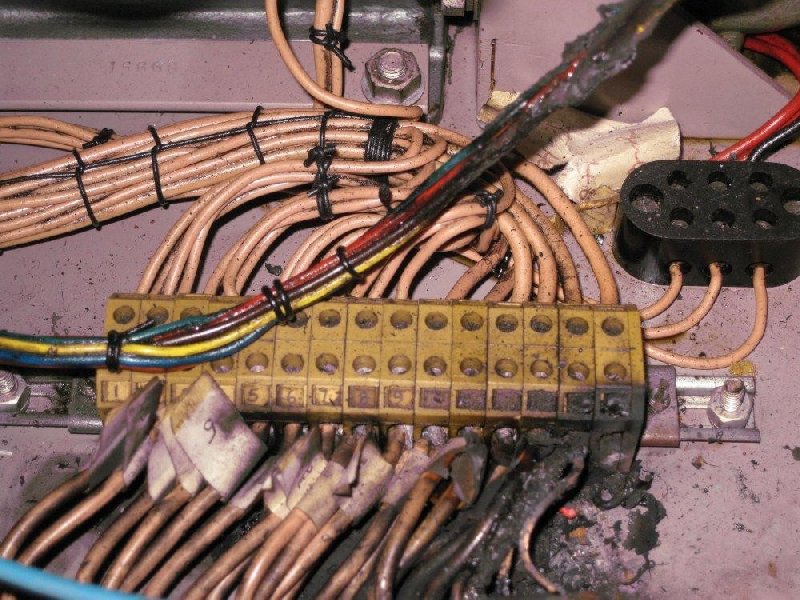
|
The terminal block showing charred wire insulation |
The cause of the fire is not known but a possibility is that a whisker of wire from a cable leading into a terminal block was very close to a neighbouring terminal, or to the metal chassis, and a particle of dirt or some conducting material bridged the gap and started an arc which in turn ignited the cable insulation. Alternatively, a terminal block screw had loosened where three wires enter one connection, leading to overheating.
About a dozen wires were charred as can be seen in the photo, and the arc had open-circuited one wire. The wires concerned are the main HT supplies of -150v, 200v and 300v, on their way into the margin control panel, and they typically carry 5 or 10 amps. Another coloured cable loom passing above the terminal block was also charred by flames, as can be seen. Two 15 amp fuses in the -150v supply were found to have blown which would have terminated the arc.
Immediate Issues
Over the following few days, the incoming electrical supply to the Pegasus site was padlocked off, and it was agreed that no one may approach the machine until an asbestos check had been carried out by external consultants. Within a few weeks, it was determined that white asbestos was present in a gasket on the motor-alternator set, and that each of over 50 Slydlok fuse carriers included a tiny tubular flash-guard containing white asbestos. Pegasus was locked up, and no one was allowed to approach it until the contaminants had been dealt with. Furthermore the embargo was applied immediately to the other objects being restored by CCS volunteers that also contained asbestos, in particular the Elliott 401 at Blythe House
At about this time, conservation staff commented that the inside of the machine was dirty and that this may have contributed to the fire. Typically, an object is cleaned by conservators when it is acquired by the museum, but this had never been fully completed because of the special way Pegasus had been taken into volunteers’ hands in 1990. Traces of oil leaking from large capacitors in the PSU had been regarded as a trivial issue, but now alarms were raised about the possibility that the machine contained polychlorinated biphenyls (PCBs), a persistent hazardous substance used as an electrical insulator, and subject to statutory regulations. An assessment was made comparing components used in the system against a database of known PCB-containing items. The total quantity of PCBs was far below the level requiring any specific action, other than monitoring that any leaking component should be replaced and safely disposed of on the precautionary principle. Fortunately the oil mentioned above was not contaminated. A programme of comprehensive cleaning of the machine was proposed by conservators, to take place when access was once again permitted
An electrical fire naturally raised the question whether the equipment conforms to electrical safety regulations, typically the IEE Wiring Regulations and their successors. Plainly, a machine built in 1959 may not conform to regulations current in 2010. However the engineering principles underlying the requirements remain much the same. The task therefore is to identify any deficiencies in terms of today’s standards and to consider whether they pose any unacceptable risks to persons or property; where the risk is deemed to be unacceptable it will be necessary to remove or minimise such a risk to an acceptable level. The safety of the inside of the equipment cabinets is a matter for general health and safety considerations and sound practice, for example that cables are adequately sized and components are appropriate to their duty. The Museum stipulated that it was not prepared to re-connect power to the machine until it had been certified to be safe. It was proposed to employ an electrical safety consultant to advise on electrical safety risk minimisation and to electrically certify the system. The museum was hesitant about taking this step on grounds of cost, and a very generous grant from the CCS to part- fund the consultant was gratefully accepted.
Procedures
The incident raised many questions at the Museum about access to museum objects by volunteers, and procedures for operating and demonstrating working objects. There appeared to be differing views in the museum on this latter point, some saying that objects should be presented on a “look but don’t touch” basis, others saying that some objects (such as computers) are meaningless unless they can be operated. A significant question in this case was whether the cost, effort and needed processes were justified at a time of significant budget cuts. Weighing on this decision was the fact that to this point it was the oldest working valve computer in the world.
All volunteers used by the museum are given training when they join on health and safety topics such as fire safety and lifting and handling, on museum policies and practices and where appropriate on interacting with museum visitors. These procedures have evolved over the last 20 years, and to an extent have passed by the Pegasus volunteers who have been in post for so long that they were considered to have accreted the necessary knowledge “on the job”. However, asbestos awareness was seen as an omission, and the working party members were enrolled on an asbestos awareness one-day course.
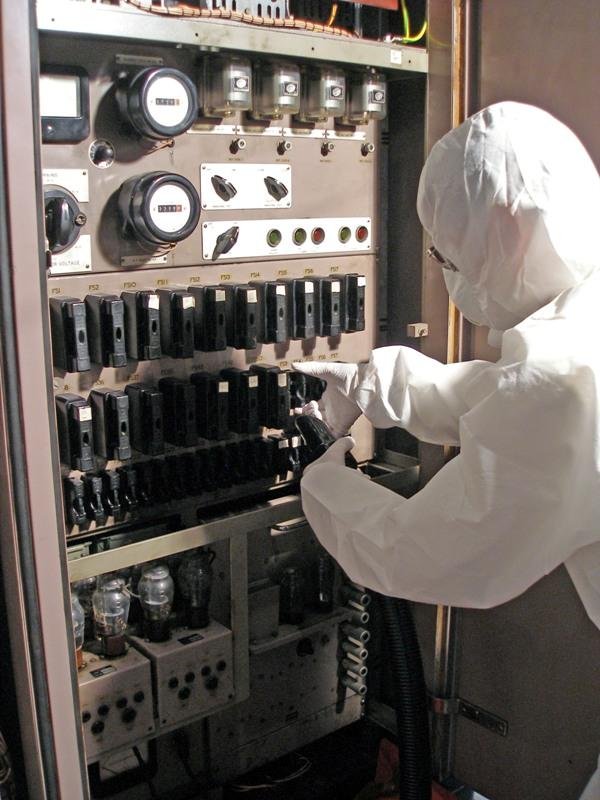
|
Replacing fuse carriers - full protective gear and vacuum hose |
Museum volunteers are also taken on into a specific rôle, such as interpreter, operator, maintainer and so on. Each such rôle has to have a comprehensive job description describing what is expected of the volunteer and what is and is not permitted. Again, this documentation has not been applied to the project team on the grounds that they already knew and understood their rôles. Some are primarily engineers who can do anything including fixing faults, others can switch-on and operate the machine, and others prefer to talk to visitors about it. However, museum policy is that the formal job descriptions should be in place, and so have to be created for the project. Preparation of these documents is the responsibility of the general volunteer coordination staff, in consultation with curators and in our case, with the volunteers themselves.
Remediation
A priority was to deal with the asbestos. The gasket was simple - it was sealed over with an impervious coating, and a label applied warning not to disturb without adopting appropriate procedures. Fortunately, the Slydlok fuses could be dealt with by replacing the carriers with the current version which has a silicone flash-guard. Amazingly, the design has not changed in over 60 years, but they are very expensive. We were able to obtain the majority unused but second-hand and half the price of new, which are available in distributors’ stocks. Each had then to be fitted with the correct gauge of fuse wire.
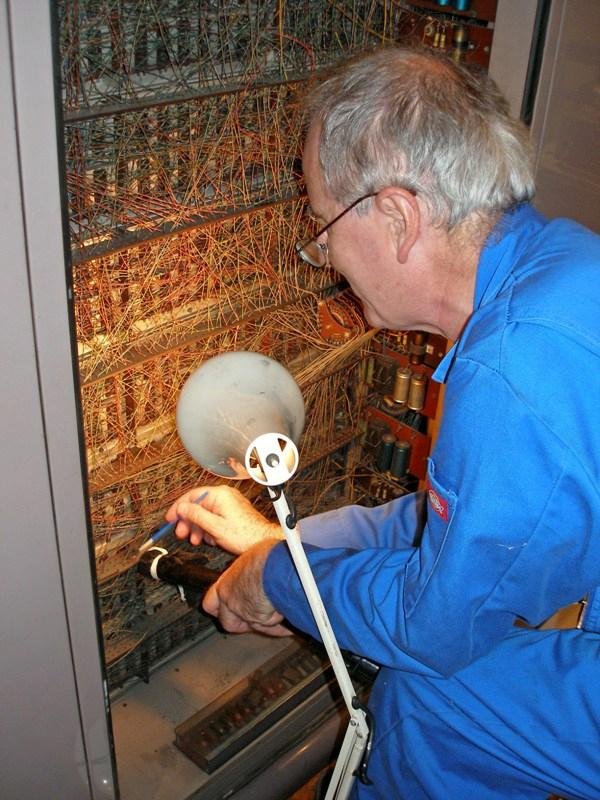
|
Volunteer cleaning CPU back-wiring |
Cleaning has been carried out in the PSU, and the central processor unit (CPU) has been carefully dust-brushed and vacuumed. This incidentally identified a couple of components which required replacing. A proposal to unplug, clean and replace all 600 plug-in packages was resisted on the grounds that samples were reasonably clean, and that wholesale damage was likely to be caused by such treatment. It is most gratifying how well the museum staff and volunteers worked together constructively on these “coal-face” activities.
Surprisingly, repair of the terminal block and wiring was harder than expected. The worst difficulty is that this part of the PSU was a late addition to the system. No drawings or documentation are available. So, all the wires had to be traced through tight and inaccessible cable looms to determine their purpose. Tentative new schematic drawings have been produced. Spare sections for the terminal block have been obtained to replace the damaged sections. We found that it is hard to fit all the wires into the terminal block, and it is proposed to fit a new larger block with more room for wiring. This will be non-authentic, but probably safer.
Aftermath
Incredibly, the machine has still not been switched on, over 15 months since the incident. Indeed, because the project leader will be out of the country until April 2011, it is likely that it will not receive power until then, a nearly two-year gap. In February 2010 a joint project and museum meeting was held to discuss the way forward. Appointment of an electrical safety consultant was discussed at the beginning of 2010. It was agreed they would be appointed once asbestos material was removed and the machine had been cleaned. The volunteer job descriptions are being prepared by a member of the project team who also has a background in health and safety.
What lessons can be learned from this sorry story? First, it is apparent that semi-informal arrangements within a museum where there is a relationship between institutional staff and external volunteers, can lead to problems. In fairness, the museum recognises this by having proper procedures for volunteers but, as a long established team of volunteers, contemporary procedures had not been applied to the Pegasus project. Secondly, a budget and museum staffing resource needs to be available to oversee volunteers if an object is to be made operational.
Thirdly, greater care in maintenance, cleaning and checking needs to be adopted by volunteers, and probably even better records kept. This is hard to do bearing in mind the limited time available from volunteers. Possibly additional specialist volunteers (e.g. cleaners) could be added to the team, though this would be a further burden on the leader.
This has been a demoralising time for the volunteers and for some museum staff. At least now that some repair and cleaning has taken place there is a good prospect that the machine will be brought back to life. We trust that it can then provide visitors and volunteers alike with more decades of an interesting and informative experience, and enhanced kudos for the Science Museum.
The author is very grateful for consultations with Dr Tilly Blyth, Curator of Computing at the Science Museum, in preparing this article.
Editor’s note: Chris Burton is a leading member of the Computer
Conservation Society having spent his career in Ferranti/ICT/ICL. He can be
contacted at
| Top | Previous | Next |
Broadly comparable to CCS, SCEN - “Stichting Computer Erfgoed Nederland” or “Dutch Computer Heritage Foundation” is an organisation of people interested in computer heritage in the Netherlands.
In March 2010, at the invitation of Doron Swade, SCEN organised a visit to the UK by a party of Dutch computer history scholars and enthusiasts. Doron organised a tour of some of our most interesting museums. This is an account of their visit and an opportunity to get an outsider’s view of our work.
In February 2009, the participants of the Now for later! conference in Amsterdam were initiated into the strategy for preserving the “New Heritage” in England, which includes historic computers. There, one of the speakers, Dr. Doron Swade, famed for constructing the Difference Engine No. 2, explained the various ways of preserving historic computers. The Difference Engine was the brainchild of the English mathematician and inventor Charles Babbage in the mid- 19th century and existed only on paper for over 150 years. However, in his time as senior curator of computing and IT at London’s Science Museum, Doron Swade and his team succeeded in building this machine using Babbage’s original plans.
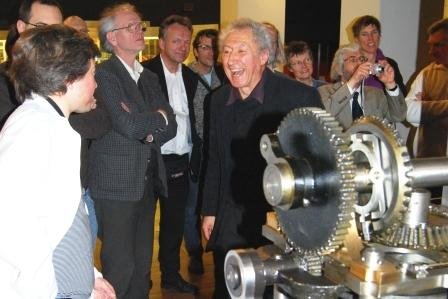
|
Doron Swade greets our guests at the Science Museum |
Excursion
One thing led to another: Dr Swade’s invitation to come and see the Difference Engine No. 2 in operation was reason for SCEN to organise an excursion. The group that eventually left for England in March 2010 included participants from SCEN but also other interested parties, such as academics and keepers of historic computer collections. The excursion was organised to increase knowledge of the management, conservation and presentation of historic computers in the Netherlands and of course to strengthen the ties between all those active in this field.
Low budget
The two-day excursion was low budget, which meant that we made extensive use of public transport. The London underground brought us where we needed to be with great speed and efficiency, while animated discussions on old computers - and anything and everything remotely connected with the subject - went on regardless. A true collector is never put off by crowded trains!
The theme and the object of the excursion
The theme of the excursion was to find out how historic computers were managed, kept and presented in England. The programme had been planned in such a way that we would be able to view not only computers in a formal museum setting, but also to attend a presentation put together and given by volunteers, where the focus was on working objects. In this way, we could clearly see what motivated the various types of collectors and how they presented their collections.

|
Willem van der Poel |
Extra dimension
The 25-strong excursion group represented the various categories of collectors and collection curators, but also included academics conducting research on computer history in the Netherlands. Professor Willem van der Poel, retired professor of informatics at the Technical University in Delft and computer pioneer in the Netherlands, deserves special mention in this connection, His presence gave the visit an extra-special dimension because he had spent many years working in England and was familiar both with a great deal of the computer technology we were introduced to and the people behind it.
Behind the scenes at the Science Museum
In London the group visited the Science Museum’s computer department. This is a grand museum, both literally and figuratively. The gallery where the first computers are housed is vast and there was a serene, cathedral-like hush when we arrived. These machines are enormous, but there is enough space to present them attractively. We were unfortunately unable to see the Ferranti Pegasus (1959), the oldest working computer in the world, in operation, but a PDP8, the first minicomputer from 1967 qualified for a great deal of attention. A timeline scale charted the development of computers.
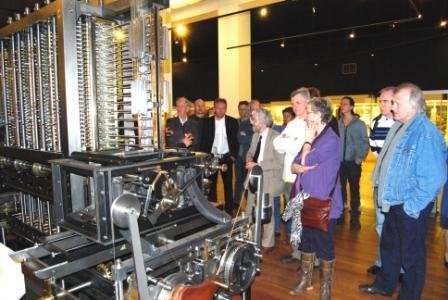
|
Watching a demonstration of the Difference Engine |
Babbage
The arrival of the curator who was to bring Charles Babbage’s Difference Engine No. 2 to life was a signal for everyone to flock around the enormous showcase in which it is housed. Once opened, we sniffed the smell of oil, and the cranking of a large handle brought the machine to life, giving the magic sound of cogs turning to make the desired calculations. Finally, a small printer showed the results. Without doubt an ingenious machine which was well ahead of its time.
Unique feat
The construction of the Difference Engine No. 2 was a unique feat. This project set out to answer the questions which had puzzled everyone since it was designed in the mid-19th century. The most common explanation for the failure to actually build the machine during Babbage’s lifetime was that it was impossible to make the approximately 8,000 parts with sufficient precision in Victorian England. There were also those who doubted whether Babbage was capable of designing a working machine. The actual construction has however demonstrated the error of the latter and that it was possible to make parts with sufficient precision in the mid-19th century. There must therefore have been other reasons for the fact that the Difference got no further than the drawing board. One of these may have been Charles Babbage’s rather difficult personality.
He was a poor communicator, especially if people knew little about the subject in question. He was also plagued by a lack of funds. Perhaps his peers were insufficiently aware of the enormous opportunities such a calculating machine could offer.
The machine was finally built in the late 1980s (and completed in 2002) in full view of the public, giving the entire project a special sense of topicality.
Tight schedule
In view of our tight schedule, there was little time for a visit to other parts of the Science Museum, but a number of participants nevertheless visited “The Making of the Modern World” exhibition. Using a large number of quite unique objects, this exhibition charts changes in society since the 19th century as a result of technological advances and inventions. A forerunner of the Difference Engine No. 2, the Difference Engine No. 1, also a calculating machine which never progressed beyond a prototype, is exhibited here. Like its successor, it never became operational.
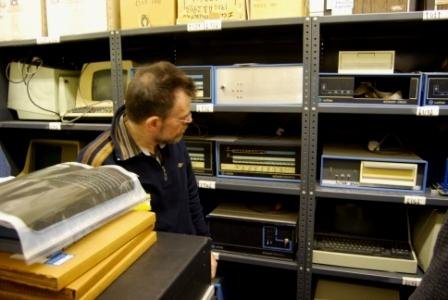
|
Exploring the treasures of Blythe House |
The Small Objects Depot
Before we visited the Science Museum, we went to the Science Museum’s Small Objects Depot in West London. This is an impressive 19th century building, quite awe-inspiring in itself, and is now used as a depot by various museums. Its curator, Tilly Blyth, gave us a tour of the extensive collection of British- made computers most of which were well known to most of the group.
Workshop closed!
Sadly, the practice of restoring computers in the depot has had to be discontinued for the time being. Health and safety requirements on site are now so strict (no naked flames, precautions against asbestos etc.) that work has been halted while new protocols are introduced. This has delayed progress and is the cause of much frustration amongst museum staff and volunteers.
On to Bletchley Park
Bletchley Park is an historic place in itself and the Second World War is still tangibly present. The buildings, referred to as blocks, shacks, or huts are an untouched reminder of the hectic scenes which this stately home witnessed during the war. The National Museum of Computing was set up here ten years ago in one of these derelict buildings. But don’t be wrong footed by the word “National”: it was a group of private enthusiasts and not any national body, that decided to reconstruct or restore the pioneering computers here at the cradle of British computer history.
Walking around Bletchley Park doesn’t give you the feeling of being in a museum, more like touring a beehive with workshops where various types of volunteers/computer enthusiasts work on their own favourite computer. The team is however planning an exhibition which will give a chronological overview of the development of computers. It will focus on the machines themselves and their technology, and will make no more than a passing reference to the developments in society of which these machines are a part.
If we thought that the Science Museum was a “cathedral”, it was no more than a humble ante-chamber compared with the National Museum of Computing which showcases a large number of computers. The public can play all kinds of computer games, so there is more interactivity than in the Science Museum.
Reconstructing the Colossus and the “Bombe”
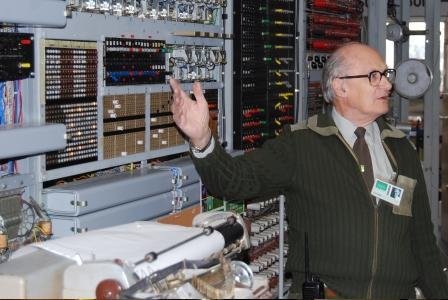
|
Tony Sale demonstrates Colossus |
The Colossus was one of the first computers to be reconstructed. This first electronic digital machine was built in 1943 specifically to decode encrypted German messages and could be programmed to some extent. For some of us, the talk by Tony Sale, the foster father of the reconstruction, was a high point of the trip. Once in operation, the Colossus gave you some idea of what it must have been like when the machine was working during the war. It was also possible to view its workings at close quarters.
Difficult job
The reconstruction of the Colossus was difficult because the post-war government had classified this and other computers as top secret and wanted them destroyed after the war. However, thanks to the people who had worked with them and those who had taken the remaining parts home with them, despite their secret status, it was possible to recreate the Colossus in its former glory. It was interesting to see that refreshing the memories of former staff brought back a great deal of their know-how, although they thought they had forgotten it all.
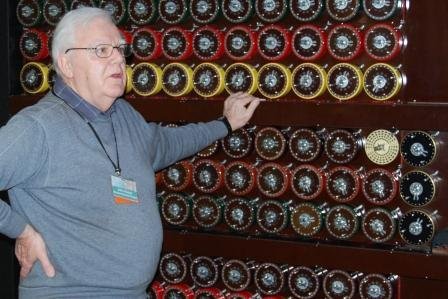
|
John Harper talks about the Bombe |
Alan Turing & the Bombe
We heard the same thing from John Harper who gave an extensive talk on the reconstruction of the Bombe, another important pioneering machine that helped decode the German Enigma codes. He ensured that the Bombe could be exhibited in operation and told his story under the all-seeing eye of Alan Turing, the spiritual father of this electro-mechanical machine, and whose statue takes pride of place beside the Bombe.
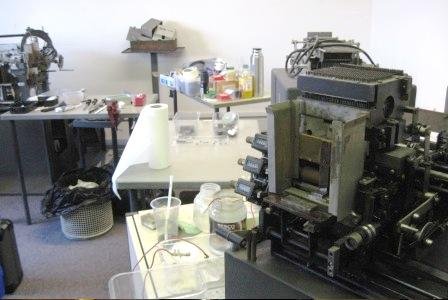
|
Powers Samas equipment under restoration at TNMoC |
Volunteers
The presence of the many volunteers at Bletchley Park, each experts in their own field, was remarkable. Most are retired but the know-how and experience they had gained during their working careers is essential for getting “their” computers operational. One volunteer was for example busy getting some of the oldest punch card machines up and running. It is clear that volunteers keep Bletchley Park going.
The National Museum of Computing is energetically led by Kevin Murrell who devotes all his spare time to the museum. Despite holding down a day job, he is the motor behind the organisation and maintains the contacts with bodies such as the British Computer Society (BCS).
Cross-links
The BCS has a separate section for historic computers: the Computer Conservation Society (CCS), set up at the initiative of Doron Swade. The CCS acts as the pivot between British IT companies and computer history and is important not only for obtaining new historic objects and for financing projects, but also for making contact with potential volunteers. It has become the platform where industry and the BCS can find and inspire each other.
A good example was the presence of Dr David Hartley, who accompanied the SCEN group on behalf of the CCS throughout most of the excursion and who contributed greatly to its success, as of course did our other hosts and hostesses.
Historic awareness
The sense of history and the awareness of being responsible for preserving the material heritage in the field of computers and IT is clearly more firmly-rooted in Great Britain than in the Netherlands. Industry and collectors (both museums and private individuals) know how to make contact with each other and are each willing to do their utmost to preserve this cultural heritage. This is further aided by the excellent relationship with the IT industry, via the CCS.
Conclusion
The trip to England has demonstrated to the SCEN excursion party that Britain has also found various ways of conserving its computer heritage. The strictly “museum” approach, such as that at London’s Science Museum, is largely dictated by legal restrictions and the rules within the museum world. There are heavy sanctions on a failure to comply with the law and for the Science Museum’s computer department this for example means that volunteers and museum professionals need to work under quite restrictive regulation. It is difficult to find alternatives and what alternatives are available are often expensive. Under new regulations some of the live restoration work done so far might not have been possible.
Pottering around
The volunteers who together set up and run the National Museum of Computing in Milton Keynes are less bothered by rules. Their motto seems to be that they’re in it for fun. The Museum is more akin to a private hobby club of like-minded souls who enjoy pottering around with computers. They don’t let anything or anyone distract them from what it’s all about: bringing historic machines back to life.
The public is welcome, very welcome even, but they are not there at the expense of the museum’s own activities. The museum is now setting up public exhibitions on various aspects of the history of IT. These will focus on the computers themselves. Computer games offer visitors the opportunity to do something for themselves. Despite the organisation’s different setup and points of departure, there is a growing trust between the National Museum of Computing and the Science Museum.
Response
The presentation method, both at the Science Museum and at the National Museum of Computing gave rise to differing responses from the SCEN excursion. The Netherlands has never had a major exhibition on Dutch IT history open to the general public, although various bodies have plans to do so. That is why it is important to continue the debate on how to tackle the presentation of this new heritage. The excursion to England has definitely contributed to this.
Invitation for a visit in return?
It would be wonderful if we could thank our English hosts and hostesses for their hospitality by extending an invitation to show them around an exhibition of IT history in the Netherlands in the near future. But we must first develop that idea.
Editor’s note: SCEN’s website is at (dead hyperlink - dutch-computer-heritage.com).
Loes Peeperkorn can be contacted at
.
The Society has its own Web site, which is located at
www.computerconservationsociety.org.
It contains news items, details of forthcoming events, and also
electronic copies of all past issues of Resurrection, in both HTML and PDF
formats, which can be downloaded for printing. We also have an FTP site at
ftp.cs.man.ac.uk/pub/CCS-Archive,
where there is other material for downloading
including simulators for historic machines. Please note that the latter URL is
case-sensitive.
CCS Web Site Information
Top Previous Next
Pioneer Profile: Ada Lovelace
Doron Swade
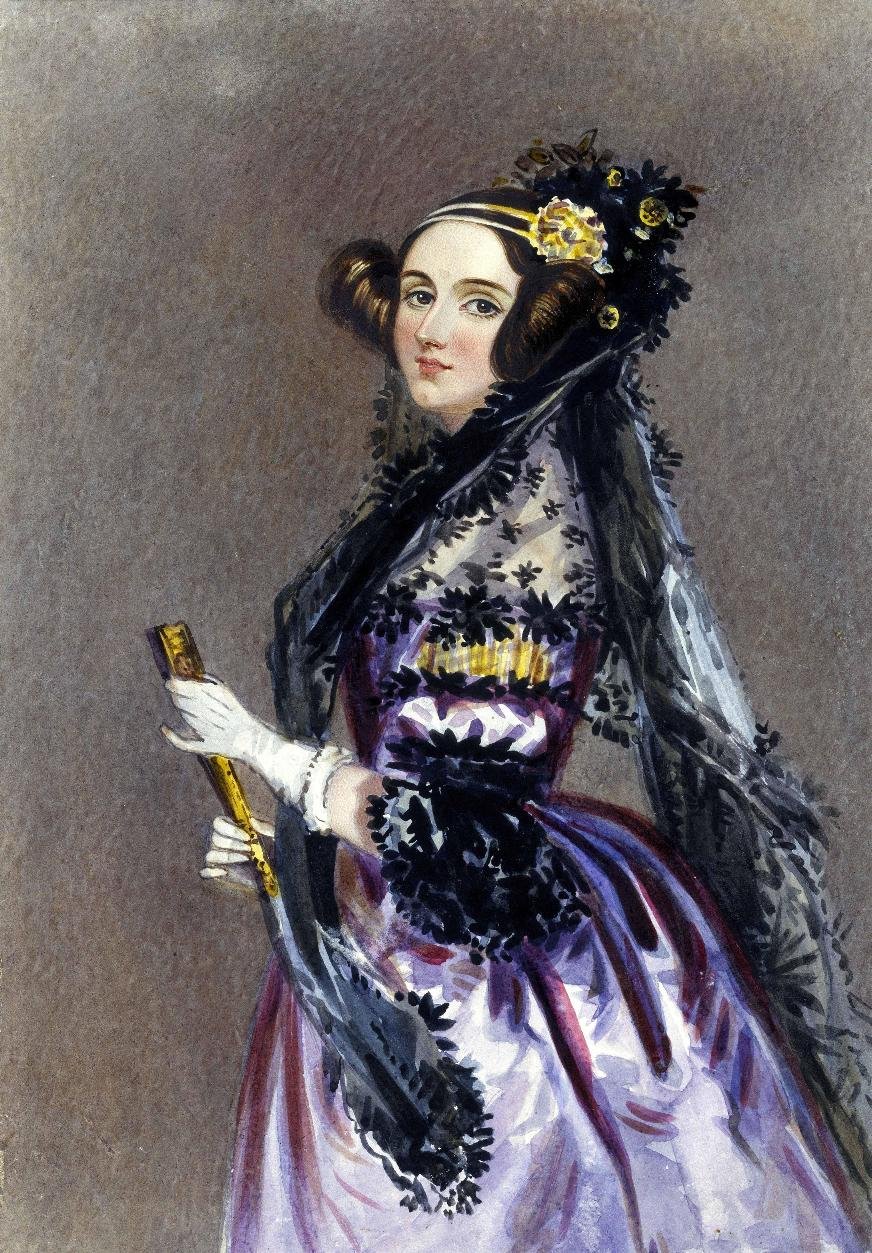
Ada Lovelace (1815-1852) is widely celebrated as a visionary figure in the history of computing. In 1979, in overt tribute to her, the US Department of Defense named the programming language “Ada” after her. The following year the Military Standard reference manual for Ada was approved on the day of Lovelace’s birthday (December 10), and the digits in its official reference, MIL-STD-1815, are those of the year of her birth. The US military, speaking as it were for modern computing, has marked Lovelace as a venerable, and possibly towering figure, in computing’s past.
There are four main claims that frequently feature in the posthumous fêting of Lovelace’s role in computing history. She is variously described as a mathematics genius, the first programmer and as someone who made an inspirational contribution to the conception and development of Charles Babbage’s calculating engines. Finally, she is frequently heralded as a prophet of the computer age. Of these four claims only one has any credible foundation.
Ada Lovelace has a double allure for historians: she was the daughter of Lord Byron whose debauched conduct outraged contemporary society as much as his poetry charmed it, and she was an associate of Babbage (1791-1871) who was her guide in the fledgling world of automatic computation in which he was the first inhabitant. Ada’s collaboration with Babbage was doubly remarkable. Women at the time had little access to higher education, barred as they were from membership of the Royal Society and from universities. Women were schooled for duty and domesticity, and wealthy aristocratic women of Ada’s class were groomed for social ornamentation and household management. Life of the mind was for men. Unusually though, Ada had had mathematical training from an early age, through the encouragement and forceful insistence of her mother, Annabella Milbanke, who was independently “modern” in her attitudes to Ada’s education. When Ada, aged 17, first met Babbage at a party in 1833 she was intrigued and captivated by his animated description of his calculating engine and his mathematical aspirations for them. Babbage became, and remained, a close family friend until her death.
Ada’s mathematical evolution was not without disruption. At 19, in 1835, she married William King, eighth Lord of Ockham, who was duly elevated to the first Earl of Lovelace three years later. Ada, never physically strong, had three children and, by 1839, was the mistress of three households, one in each of London, Somerset and Surrey. With motherhood, domestic duties and erratic health she had little time for mathematics or for Babbage’s engines. But in 1840, under Augustus De Morgan, she resumed her study of the rudiments of mathematics. Early the following year she wrote to Babbage that she was “now studying attentively the Finite Differences”, the mathematical principle on which Babbage’s Difference Engines were based.
The timing of events here is significant. Babbage conceived of Difference Engine No. 1 in 1821 when Ada was five, and he had completed the major design work by 1831. By the time Ada resumed her studies in 1840 he had also completed his major work on the Analytical Engine, the first design for a programmable general-purpose computing machine, conceived in 1834. It is clear that the conception and the pioneering work on both engines were complete before Ada had contact with even the elementary principles of the first engine. Any claim that Ada influenced the conception or technical development of either engine is contradicted by the simple order of events.
Ada is frequently described as a mathematics genius. There is no evidence for this tribute. Babbage was himself a highly accomplished and modestly original mathematician with a dozen or so serious mathematical publications to his credit by the time he was 30. But he discovered no new theorems and left no lasting legacy. His inspired pioneering work on computation was not regarded as part of mathematics so falls outside this evaluation. Ada published no mathematical papers and made no new findings. For all her fervour she was a talented beginner. If her mathematical abilities were exceptional we shall never know. She died in 1852 at the age of 36.
Most frequently Ada is described as “the first programmer”. This is understandable but misguided. Ada translated a paper published in French by the Italian engineer, Luigi Menabrea, describing the principles and operation of Babbage’s Analytical Engine. Menabrea’s paper was based on an address by Babbage to a gathering in Turin in 1840 which Menabrea attended. Ada added extensive notes of her own which ran to three times the length of the original article. The notes were written during a frenetic and sometimes irritable collaboration with Babbage in 1843 during which she badgered him for explanations. Sketch of the Analytical Engine, Ada’s English translation of Menabrea’s paper with her notes, was published that year in Scientific Memoirs. It was the most substantial account of the Analytical Engine published in Babbage’s lifetime and is highly revealing of contemporary thinking about automatic computing machines.
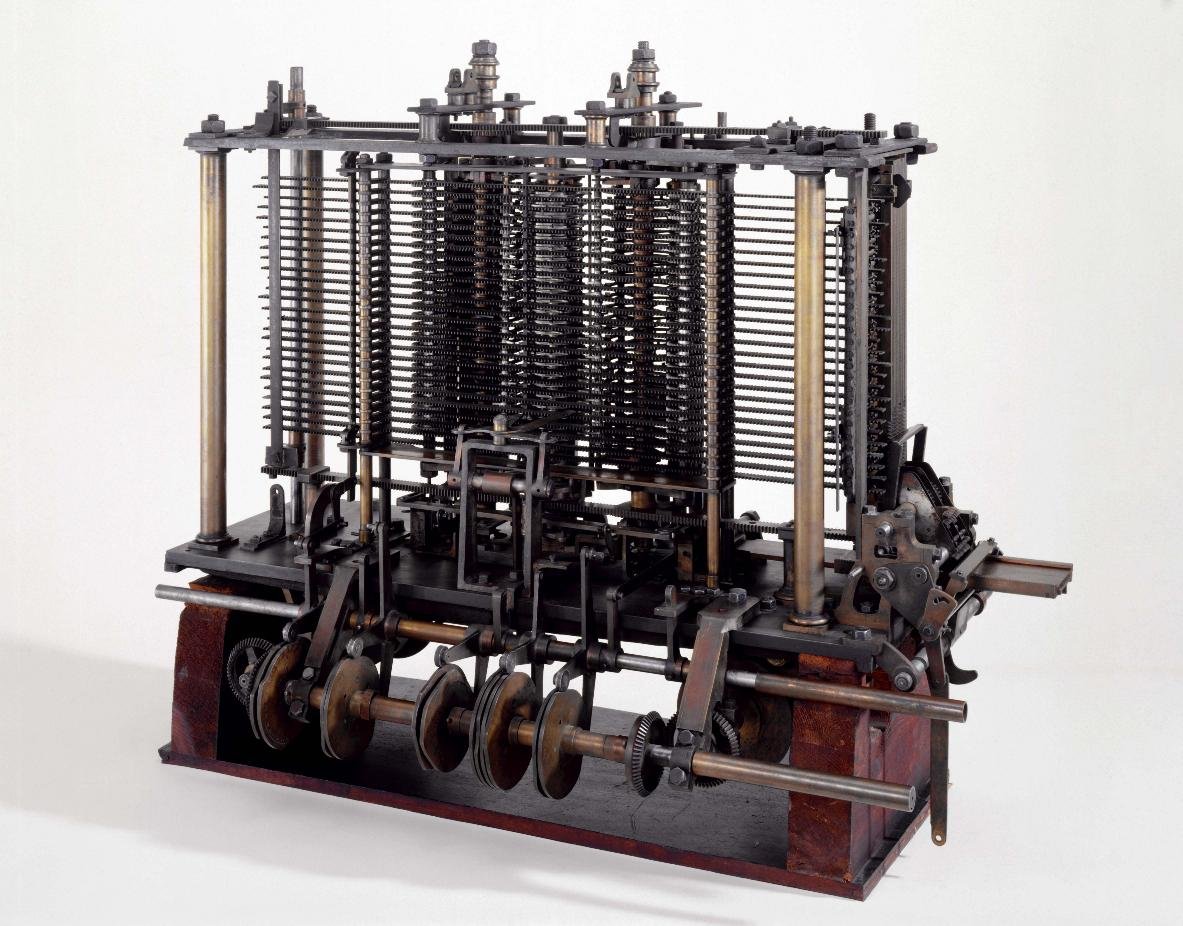
|
Small experimental piece of the unbuilt Analytical Engine |
Sketch appeared under Ada’s initials to obscure the fact that the author was a woman, though the identity of the writer was no secret within the scientific community. The notes contain examples of algorithmic stepwise sequences of operations executed by the notional Analytical Engine to find solutions, what we would now call “programs”, though neither Babbage nor Ada used these terms. The most detailed worked example was a “program” to compute Bernoulli numbers.
So the first published example of a “program” appeared under Ada’s name. While it is edifying to describe her as “the first programmer” and therefore the originator of the practices and procedures of computational solution by machine, it is misleading to do so. Those familiar with the archival sources are clear that the techniques and examples in the paper were those devised by Babbage much earlier and suggested or supplied by him.
The final claim made for Ada, that she was a computing visionary, is one that can be substantiated, though it is useful to be clear about the respects in which this might be so. In Babbage’s conception, the Analytical Engine, revolutionary as it was, operated essentially on numbers. In 1836 he hinted at a universal algebra machine capable of manipulating algebraic symbols without reference to numerical value. But the ideas are undeveloped and he wrote that “it would be better to construct a new engine for such purposes”. In any event the context of Babbage’s work remained mathematical and it is not evident that he envisaged that number could usefully represent entities other than quantity.
It was Lovelace who appears to have made the essential transition in understanding. Babbage saw the Analytical Engine as a sophisticated programmable computing machine capable of executing any sequence of arithmetical operations under program control, but still operating only on number. Ada saw the potential of computational machines to manipulate symbols of which number was but one example. She speculates that if the rules of harmony and composition were appropriately represented then the Analytical Engine “might compose elaborate and scientific pieces of music of any degree of complexity or extent”. She also wrote of the machine operating on numbers directly representing entities other than quantity “as if they were letters or any other general symbols” and that it might produce outputs in notational form. Nowhere, at least in his published writings, does Babbage write in this way nor does he speculate about his machines in any context other than mathematical.
In this Ada saw what none of her contemporaries, Babbage included, appear to have seen. Ascribing this essential and historic understanding to her is not a backwards projection from our own age. She is explicit. This is Ada, banging the table, saying it is this that is significant and revolutionary about automatic computation. So Lovelace is rightly celebrated but not for the reasons commonly cited.
Sketch was her only publication and Ada’s ambitions for the life of a luminary were tragically thwarted. Her death in 1852 was painful and grim. Her illness remained undiagnosed till late in the day. It is regrettable that disputes over Ada’s greatness and the extent to which the authorship of the notes was Babbage’s or hers have diverted attention from a deeper study of her ideas.
| Top | Previous | Next |
| 20 Jan 2011 | Homo sapiens, cultural evolution and computing - a perspective | George Mallen |
| 17 Feb 2011 | The Evolution of Hard Disk Drives | Neil Macphail |
| 17 Mar 2011 | Earthquake or Explosion - Computers in Seismology applied to Test-Ban Verification |
Alan Douglas |
| 21 Apr 2011 | The story of Elliott-Automation computers, 1946 - 1986 |
Simon Lavington |
| 19 May 2011 | Air Traffic Control systems | John Smith & others of TNMoC |
London meetings take place in the Fellows’ Library of the Science Museum, starting at 14:30. The entrance is in Exhibition Road, next to the exit from the tunnel from South Kensington Station, on the left as you come up the steps.
Queries about London meetings should be addressed to Roger Johnson at , or by post to Roger at Birkbeck College, Malet Street, London WC1E 7HX.
| 18 Jan 2011 | The Harwell Dekatron Computer | Kevin Murrell & Tony Frazer |
| 15 Feb 2011 | Is it 0 or 1? A Look at Past and Future Methods for Physical Data Storage |
Steve Hill |
| 15 Mar 2011 | The Evolution of Radar Systems, Computers and Software |
Frank Barker |
North West Group meetings take place in the Conference Room at MOSI - the Museum of Science and Industry in Manchester - usually starting at 17:30; tea is served from 17:00. Queries about Manchester meetings should go to Gordon Adshead at .
Details are subject to change. Members wishing to attend any meeting are advised to check the events page on the Society website at www.computerconservationsociety.org for final details which will be published in advance of each event. Details will also be published on the BCS website (in the BCS events calendar) and in the Events Diary columns of Computing and Computer Weekly.
MOSI : Demonstrations of the replica Small-Scale Experimental Machine at the Museum of Science and Industry in Manchester are expected to resume from February 2011 (but check MOSI’s website).
Bletchley Park : daily. Guided tours and exhibitions, price £10.00, or £8.00 for concessions (children under 12, free). Exhibition of wartime code-breaking equipment and procedures, including the replica Bombe and replica Colossus, plus tours of the wartime buildings. Go to www.bletchleypark.org.uk to check details of times and special events.
The National Museum of Computing : Thursday and Saturdays from 13:00. Entry to the Museum is included in the admission price for Bletchley Park. The Museum covers the development of computing from the wartime Colossus computer to the present day and from ICL mainframes to hand-held computers. See www.tnmoc.org for more details.
Science Museum :. Pegasus “in steam” days have been suspended for the time being. Please refer to the society website for updates.
North West Group contact detailsChairman Tom Hinchliffe: Tel: 01663 765040. |
| Top | Previous | Next |
| Chairman Dr David Hartley FBCS CEng | |
| Secretary Kevin Murrell | |
| Treasurer Dan Hayton | |
| Chairman, North West Group Tom Hinchliffe | |
| Secretary, North West Group Gordon Adshead | |
| Editor, Resurrection Dik Leatherdale MBCS | |
| Web Site Editor Alan Thomson | |
| Archivist Hamish Carmichael FBCS | |
| Meetings Secretary Dr Roger Johnson FBCS | |
| Digital Archivist Professor Simon Lavington FBCS FIEE CEng | |
Museum Representatives | |
| Science Museum Dr Tilly Blyth | |
| MOSI Catherine Rushmore | |
| Codes and Ciphers Heritage Trust Pete Chilvers | |
Project Leaders | |
| Colossus Tony Sale Hon FBCS | |
| Elliott 401 & SSEM Chris Burton CEng FIEE FBCS | |
| Bombe John Harper Hon FBCS CEng MIEE | |
| Elliott 803 Peter Onion | |
| Ferranti Pegasus Len Hewitt MBCS | |
| Software Conservation Dr Dave Holdsworth CEng Hon FBCS | |
| ICT 1301 Rod Brown | |
| Harwell Dekatron Computer Tony Frazer | |
| Our Computer Heritage Simon Lavington FBCS FIEE CEng | |
| DEC Kevin Murrell | |
| Differential Analyser Dr Charles Lindsey | |
| ICL 2966 Delwyn Holroyd | |
| EDSAC TBA | |
Others | |
| Professor Martin Campbell-Kelly | |
| Peter Holland | |
| Dr Doron Swade CEng FBCS MBE |
Readers who have general queries to put to the Society should address them to the Secretary: contact details are given elsewhere. Members who move house should notify Kevin Murrell of their new address to ensure that they continue to receive copies of Resurrection. Those who are also members of the BCS should note that the CCS membership is different from the BCS list and is therefore maintained separately.
| Top | Previous |
The Computer Conservation Society (CCS) is a co-operative venture between the British Computer Society, the Science Museum of London and the Museum of Science and Industry (MOSI) in Manchester.
The CCS was constituted in September 1989 as a Specialist Group of the British Computer Society (BCS). It thus is covered by the Royal Charter and charitable status of the BCS.
The aims of the CCS are to
Membership is open to anyone interested in computer conservation and the history of computing.
The CCS is funded and supported by voluntary subscriptions from members, a grant from the BCS, fees from corporate membership, donations, and by the free use of the facilities of both museums. Some charges may be made for publications and attendance at seminars and conferences.
There are a number of active Projects on specific computer restorations and early computer technologies and software. Younger people are especially encouraged to take part in order to achieve skills transfer.
| ||||||||||